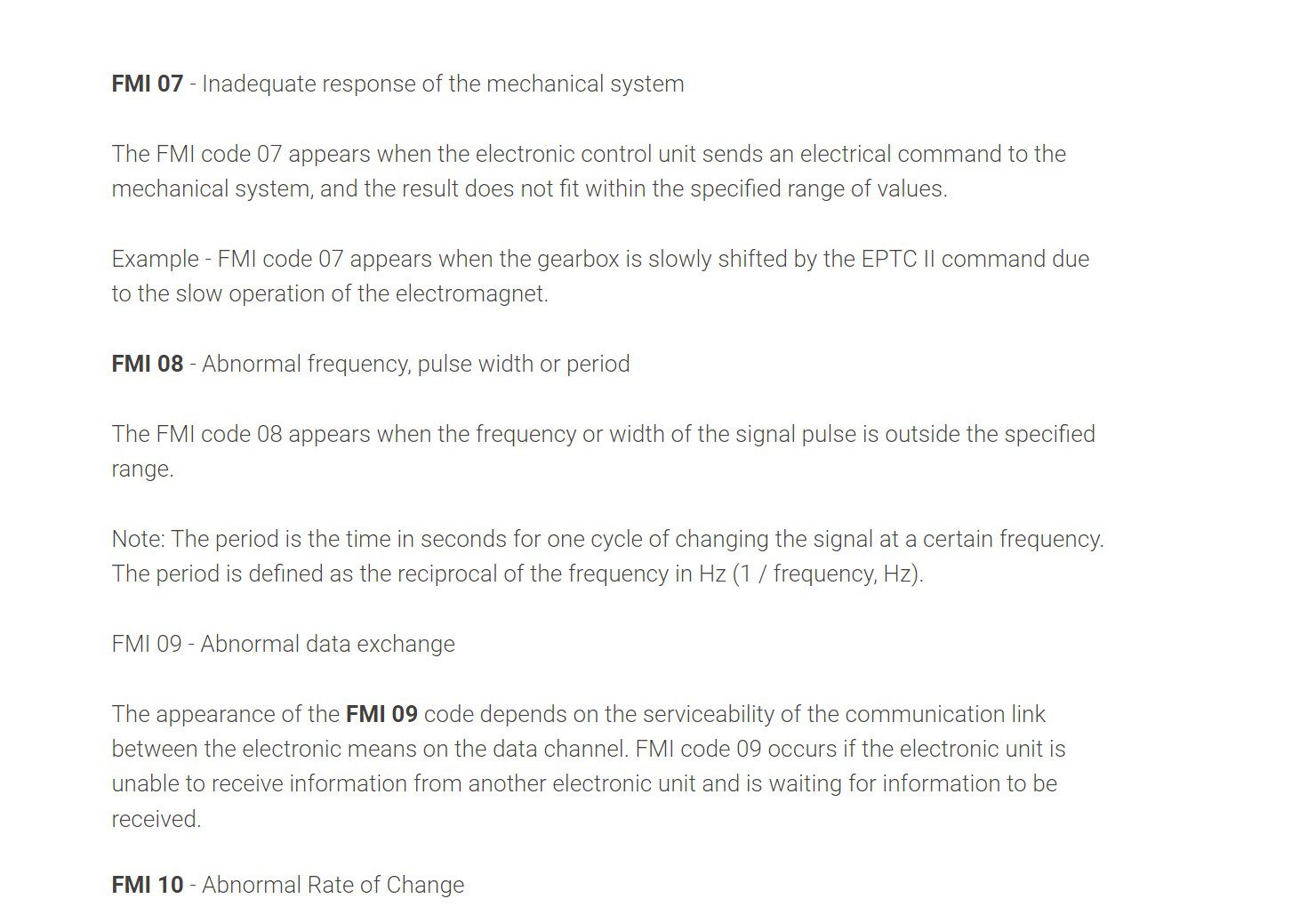FMI is a diagnostic fault code, it indicates the type of failure.
Diagnostic type trouble codes (FMI)
0 Data are reliable, but not too high
1 Data are reliable, but much understated
2 Data is messy, intermittent or not true
3 Voltage higher than normal
4 Voltage is below normal
5 Current is below current
6 Current is above normal
7 incorrect reaction of the mechanical system
8 Abnormal frequency, pulse width or signal period
9 Incorrect data exchange
10 too fast rate of change
11 type of fault not known
12 Faulty device or component
13 Parameters outside the calibration range
Error comments
FMI 00 – The data are reliable, but exceed the normal operating range of the parameter change.
For each electronic control system, the upper limit of the expected operating range of the signal value change is set. The upper limit is set based on the expected maximum value of the parameters (for example, the temperature of the torque converter). A sensor that continues to function but generates a signal whose value is higher than the expected upper limit will cause the FMI 00 code to be registered.
Example – The normal factor of the sensor signal with pulse-width modulation (the value proportional to the width of pulses) should not exceed 80%. If the sensor generates a signal with a duty ratio of 81%, it means that it continues to function, but the signal value exceeds the set upper limit of its range.
FMI 01 – The data is reliable, but below the normal operating range of the parameter change
For each electronic control system, the lower limit of the expected operating range of the signal value change is set. The lower limit is set based on the expected minimum value of the parameters (eg oil pressure in the engine). A sensor that continues to function but generates a signal whose value is below the expected lower limit will cause the FMI 01 code to be registered.
Example – The minimum filling factor of most sensors with pulse-width modulation is at least 5%. If the sensor generates a signal with a duty cycle of 3%, it means that it continues to function, but the signal value is below the set lower limit of its range.
FMI 02 – Data is erratic, intermittent or incorrect
The appearance of the FMI 02 code occurs when there is a signal from the corresponding component. Then, the signal information data can be changed as follows.
• The data disappears.
• Data becomes unstable.
• The data becomes incorrect.
The values of the data at certain intervals can be correct, but not in others. The appearance of this code can also be associated with an incorrect exchange of information between electronic units. For example, in the case where the VIMS system requests engine speed data from the engine control unit via a data link from Caterpillar.
FMI 03 – Voltage above normal or short circuit to a higher voltage circuit
The FMI code 03 appears in cases where the voltages measured in a particular system or element become high. The reason for the appearance of the code FMI 03 is often associated with signal circuits.
The reason for the appearance of the FMI 03 code can be the following elements of the system.
• Sensor
• Harness wiring harness
• Suitable electronic control units
The possible reasons for the appearance of the FMI 03 code may be the following circumstances.
• The sensor generates an AC signal (per operating cycle), and the signal hangs at the maximum value.
• The signal wire in the harness is shorted to the power supply circuit of the sensor or to a circuit under voltage that exceeds the voltage of the power supply.
• A rupture in the signal wire between the sensor and the electronic control unit. On the input circuits of electronic monitoring and control devices, positive voltage is usually maintained. For example, if the sensor is disconnected, the voltage in the input circuit of the control unit will be 5 VDC.
• In the electronic control unit, there is an internal short circuit of the sensor signal circuit contact in the connector with the positive power supply circuit. In addition, the faulty electronic control unit may not correctly sense the normally functioning signal circuit of the sensor.
FMI 04 – Voltage below normal or short to a circuit with a lower voltage
The FMI code 04 is similar to the FMI code 03. However, the FMI code 04 indicates that the voltage values are below acceptable values. The appearance of the FMI code 04 is most often associated with a malfunction of the signal circuits. The FMI code 04 is similar to the FMI 06 code and is sometimes used instead.
The reason for the appearance of the FMI 04 code can be the following elements of the system.
• Sensor
• Harness wiring harness
• Suitable electronic control units
The following reasons may be the possible reason for the appearance of the FMI 04 code.
• Sensor signal hangs at a low level or level close to the mass potential.
• The signal wire in the harness is shorted to ground.
• There is a short in the electronic control unit of the connector’s signal contact to ground.
FMI 05 – Current is too low or the circuit is open
The FMI 05 code appears in cases where the electronic control unit determines that the current values are low.
The most likely cause of the appearance of the FMI 05 code is the circuit breaks or poor contact in the harness connectors.
FMI 06 – Current is above normal or the circuit is closed to ground
The FMI code 06 is similar to the FMI code 05. However, the FMI code 06 indicates that the current is too high. The appearance of the FMI 06 code is most often associated with a malfunction of the output circuits in the electronic control units.
Example – FMI code 06 appears when the circuit is shorted to ground.
The reasons for the appearance of the codes FMI 06 and FMI 04 are very similar, and the FMI 06 code is sometimes used instead of the FMI code 04.
The FMI code 07 appears when the electronic control unit sends an electrical command to the mechanical system, and the result does not fit within the specified range of values.
Example – FMI code 07 appears when the gearbox is slowly shifted by the EPTC II command due to the slow operation of the electromagnet.
FMI 08 – Abnormal frequency, pulse width or period
The FMI code 08 appears when the frequency or width of the signal pulse is outside the specified range.
Note: The period is the time in seconds for one cycle of changing the signal at a certain frequency. The period is defined as the reciprocal of the frequency in Hz (1 / frequency, Hz).
FMI 09 – Abnormal data exchange
The appearance of the FMI 09 code depends on the serviceability of the communication link between the electronic means on the data channel. FMI code 09 occurs if the electronic unit is unable to receive information from another electronic unit and is waiting for information to be received.
FMI 10 – Abnormal Rate of Change
The appearance of the FMI code 10 is associated with more or less than the expected rate of change in the signal.
Example – This code is generated if the signal from the output shaft speed sensor on the dump truck indicates that the dump truck accelerates faster than it can in its actual operation.
FMI 11 – Fault type not defined
The FMI code 11 appears when the electronic unit registers more than one FMI code for one fault.
FMI 12 – Faulty device or component
The FMI code 12 indicates the following status: the electronic control unit sends a signal to another electronic unit via the data link. The electronic unit is waiting for a response, but either does not receive any response, or receives an incorrect response.
The FMI code 12 can also indicate the following status:
The electronic unit is expected to periodically send data, but does not send.
The appearance of the FMI code 12 may also be associated with a data link failure.
FMI 13 – Parameter outside calibration
With this state of the mechanical part, the electrical signal parameters go beyond the limits set by the electronic control unit.


